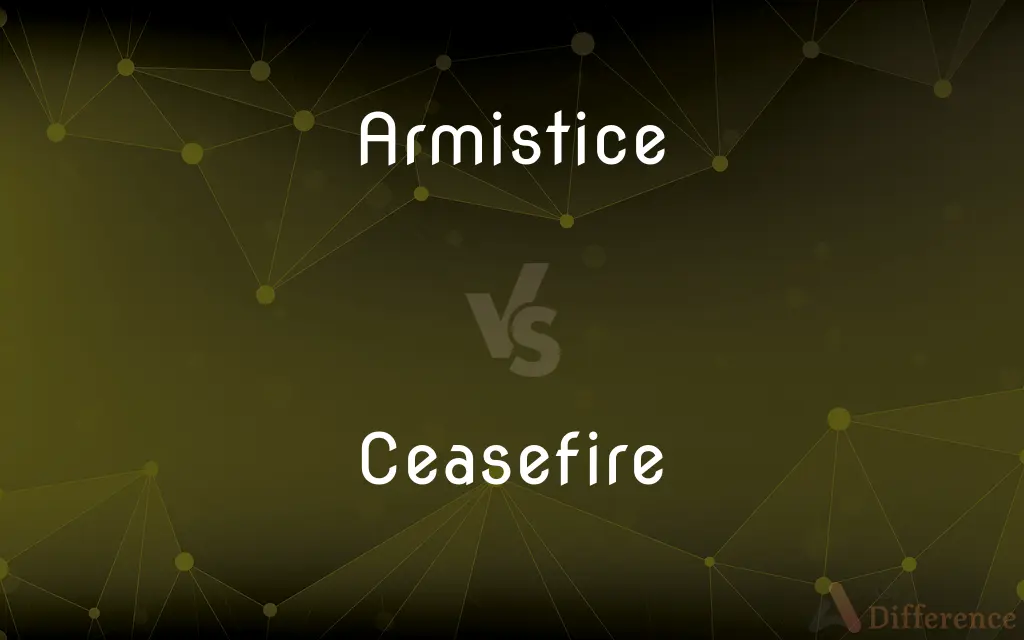Armistice vs. Ceasefire — What's the Difference?
By Maham Liaqat & Urooj Arif — Updated on April 20, 2024
Armistice refers to a formal agreement between warring parties to stop fighting and negotiate peace, while a ceasefire is a temporary halt to conflict without discussing future terms.

Difference Between Armistice and Ceasefire
Table of Contents
ADVERTISEMENT
Key Differences
An armistice is a comprehensive agreement intended to end hostilities and pave the way for peace negotiations, usually formalized through a written agreement. In contrast, a ceasefire is often a temporary arrangement that pauses fighting, allowing for humanitarian relief or further diplomatic talks.
Armistices are typically the result of negotiations and are aimed at creating a stable environment for drafting a peace treaty. On the other hand, ceasefires might be declared unilaterally or bilaterally and do not necessarily lead to longer-term peace discussions.
The terms of an armistice are generally more detailed, outlining the conditions for cessation of hostilities and the steps towards peace. Ceasefires, however, are usually less formal and might not include detailed terms beyond the cessation of aggressive actions.
Historically, armistices have marked significant ends to conflicts, such as the Armistice of 11 November 1918, which ended the fighting in World War I on the Western Front. Ceasefires, meanwhile, are commonly used in ongoing conflicts to temporarily stop fighting, such as in Syria or Ukraine.
The enforcement of an armistice often involves international oversight or the presence of peacekeeping forces to ensure compliance. Conversely, ceasefires might rely more on the mutual interests of the parties involved to maintain the cessation of hostilities without external enforcement.
ADVERTISEMENT
Comparison Chart
Definition
A formal agreement to stop fighting and negotiate peace.
A temporary halt to conflict without set future terms.
Formality
Usually formal and detailed.
Often informal and less detailed.
Duration
Intended to lead to a permanent peace treaty.
Generally temporary, with no guarantee of leading to peace.
Historical Examples
Armistice of 11 November 1918 (WWI).
Korean War ceasefire (1953-present).
Enforcement
Often involves international oversight.
May depend on parties' mutual interests or external pressure.
Compare with Definitions
Armistice
A ceasefire coupled with an agreement to negotiate peace.
The armistice included terms for troop withdrawals and disarmament.
Ceasefire
A temporary stop in fighting, usually not formalized.
The commander declared a ceasefire to allow evacuation of civilians.
Armistice
A formal agreement by warring parties to stop fighting.
The two countries signed an armistice to end the conflict and begin peace negotiations.
Ceasefire
Often declared to facilitate humanitarian aid.
The ceasefire allowed international agencies to deliver food and medical supplies.
Armistice
Typically supervised by international organizations.
The United Nations supervised the enforcement of the armistice.
Ceasefire
May be fragile and easily broken.
The ceasefire was broken within hours after mutual accusations of violations.
Armistice
A precursor to a peace treaty.
The armistice provided the groundwork for a comprehensive peace treaty.
Ceasefire
Does not necessarily lead to peace negotiations.
The ceasefire paused the fighting but was followed by a resumption of hostilities.
Armistice
Marks a significant step towards ending a war.
The signing of the armistice was celebrated as the end of hostilities.
Ceasefire
Can be unilateral or bilateral.
The ceasefire was unilaterally declared but later accepted by the opposing forces.
Armistice
An armistice is a formal agreement of warring parties to stop fighting. It is not necessarily the end of a war, as it may constitute only a cessation of hostilities while an attempt is made to negotiate a lasting peace.
Ceasefire
A ceasefire (or truce), also spelled cease fire (the antonym of 'open fire'), is a temporary stoppage of a war in which each side agrees with the other to suspend aggressive actions. Historically, the concept existed at least by the time of the Middle Ages, when it was known as a 'truce of God'.
Armistice
A temporary cessation of fighting by mutual consent; a truce.
Ceasefire
An order to stop firing.
Armistice
A (short) cessation of combat; a cease-fire, a truce.
Ceasefire
Suspension of active hostilities; a truce.
Armistice
A formal agreement, especially between nations, to end combat.
Ceasefire
Alternative spelling of cease-fire
Armistice
Alternative case form of Armistice
Armistice
A cessation of arms for a short time, by convention; a temporary suspension of hostilities by agreement; a truce.
Armistice
A state of peace agreed to between opponents so they can discuss peace terms
Common Curiosities
Can a ceasefire lead to an armistice?
Yes, a ceasefire can sometimes lead to negotiations that result in an armistice.
What is the main purpose of an armistice?
To provide a formal framework for ending hostilities and starting peace negotiations.
How does a ceasefire differ from a truce?
A ceasefire is specifically for stopping all military action temporarily, whereas a truce may involve partial or conditional halts to fighting.
What role do third parties play in negotiating armistices?
Third parties, such as neutral nations or international organizations, often play crucial roles in facilitating negotiations and ensuring the terms of an armistice are fair and sustainable.
How are ceasefires monitored?
Monitoring mechanisms may include satellite surveillance, on-ground observers from international peacekeeping forces, or local watchdog groups.
What mechanisms ensure compliance with a ceasefire?
Compliance mechanisms can include monitoring by international organizations, sanctions for violations, and local or international mediators.
What happens if an armistice is violated?
Violations of an armistice can lead to the resumption of hostilities, international condemnation, or sanctions, depending on the terms of the armistice and the involvement of international bodies.
Are ceasefires effective in civil wars?
Ceasefires in civil wars can be particularly challenging due to the multiple factions involved and the lack of centralized control, often resulting in frequent violations.
What legal implications does an armistice have?
An armistice is legally binding on the parties involved, often backed by international law.
Is a ceasefire effective in stopping conflicts?
While ceasefires can temporarily halt hostilities, they do not resolve underlying conflicts and are often violated.
Does a ceasefire need approval from higher authorities or international bodies?
Approval from higher authorities is common, especially in organized military structures, but international approval is not typically necessary unless the ceasefire is part of a broader peace process.
How long does an armistice last?
An armistice is intended to last until a permanent peace treaty is negotiated, although the duration can vary significantly based on the conflict.
What legal documents are required to establish an armistice?
An armistice usually requires a formal agreement, documented and signed by the parties involved, often with international witnesses or mediators.
Can civilians benefit from a ceasefire?
Yes, ceasefires often aim to provide humanitarian relief to civilians, such as safe passage, access to medical care, and food supplies.
Share Your Discovery

Previous Comparison
Lest vs. Unless
Next Comparison
Process vs. WiseAuthor Spotlight
Written by
Maham LiaqatCo-written by
Urooj ArifUrooj is a skilled content writer at Ask Difference, known for her exceptional ability to simplify complex topics into engaging and informative content. With a passion for research and a flair for clear, concise writing, she consistently delivers articles that resonate with our diverse audience.
















































